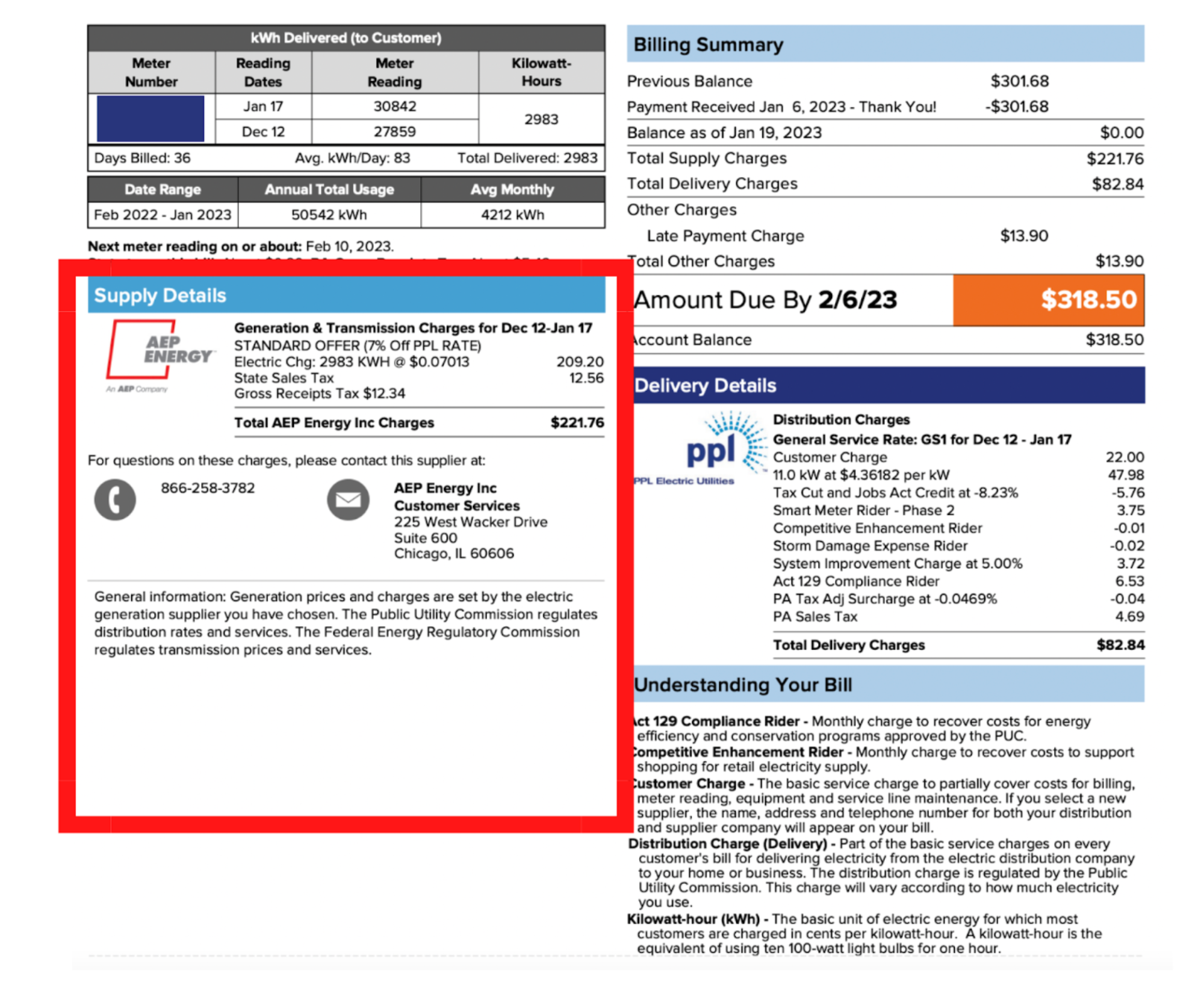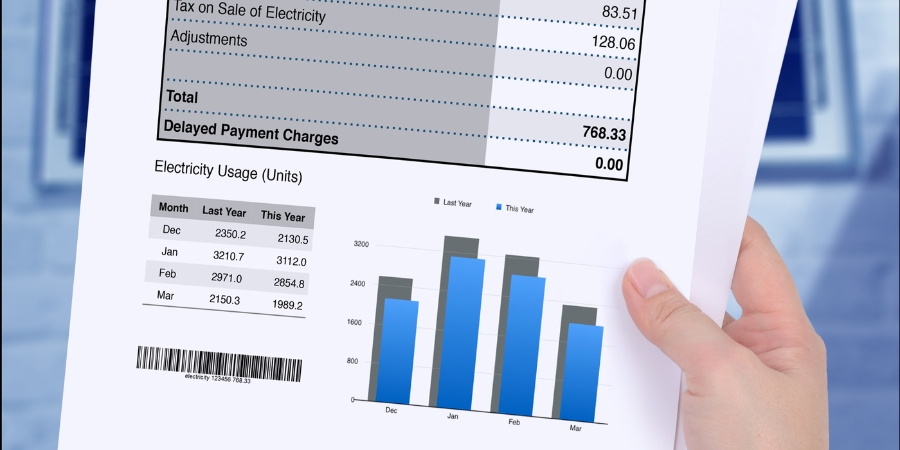If you own or operate a business, then you already know that your business electricity bill can be a significant expense. And, business energy bills can be complicated to dissect and fully understand. In fact, there are several energy billing components that make up the total utility charges on an electric bill. Understanding business electricity charges is paramount to controlling your energy expenses. This article outlines the anatomy of a commercial electricity bill, how to utilize business utility audits to control costs, and how hiring a business energy broker or consultant might be the best decision for your bottom line.
Learning How To Read Your Energy Bill
First, it’s important to understand how to simply read your electricity bill. On most electric utility bills, there are different billing units that make up the total invoice. In most deregulated states, commercial customers pay for their total electricity demand in dollars per kilowatt ($/kW) and their electricity supply in dollars per kilowatt hour ($/kWh). Understanding the difference between kW and kWh is critical to calculating your total energy expenses.
Furthermore, if you own a business and have signed up with a third-party energy supplier, that company might elect to send you a separate invoice for electricity supply charges. This billing arrangement is known as a dual bill. If you happen to receive a dual bill from an energy provider, those charges are always for electricity supply and are typically billed in $/kWh.
Let’s discuss the basics of a business energy bill…
What A Business Electric Bill Consists Of
There are two major components of a commercial energy bill. Whether your business is located in a regulated or deregulated state, your electricity bill contains charges for the delivery of electricity to your business or building. And, your bill also includes charges for the supply of electricity or the total amount of energy your business consumes during any given billing period. Let’s look at each of these in more detail.
Delivery Charges
Electric utility delivery charges are the costs for the local utility company to send power to your business premises. These charges also include the costs for the utility company to maintain the local power lines, handle power outages, and manage the billing of your account. In this sample commercial PPL electric bill below, you will notice that on the cover page of the bill, the delivery charges are separated from the supply charges:

The total bill is $304.60. Approximately 27% of the total commercial electric bill in PPL is for utility delivery charges, or $82.84. These charges are billed by the local utility company in dollars per kW as evidenced by the detailed calculations on page 2 of this bill below:

Supply Charges
Supply charges, on the other hand, differ from delivery charges for electricity. The electric supply costs on a bill are for the total electricity consumption. In simple terms, these charges are for the physical electricity commodity that is being consumed by your business. As you can see from the same sample bill, the electric supply costs make up approximately 83% of the total bill:

This particular customer just happens to be using an energy broker in a deregulated state to find lower-cost electricity rates. As you can see from this bill, this customer signed up with the third-party energy supplier, AEP Energy Inc, and AEP Energy is billing this customer $0.07013/kWh for their electricity supply.
Even businesses located in deregulated states have the option to elect for the standard utility offer for energy supply. And, with the exception of Texas, commercial customers in these states are not obligated to sign up with a supplier. As you can see on this bill, the PPL Electric Utilities Price to Compare is advertised as being $0.14751/kWh.
This customer happens to be saving over 50% compared to PPL’s standard offer price to compare for electricity supply.
Now, let’s look at the supplier calculations on page 2 of this bill:

As you can see, AEP is billing this customer in dollars per kWh. The customer used a total of 2,983 kWh for this billing period and they were charged at $0.07013 per kWh for a total amount of $209.20. In Pennsylvania, electricity suppliers also are required to collect a Gross Receipts Tax, which happens to be accounted for on this bill.
How To Reduce Business Electricity Bill Costs
There are several ways to reduce your electricity costs at your business. Understanding your electric bill and how it is calculated is a great first step. Next, you can look for ways to reduce your total costs by using some of the following energy-saving tips.
Get A Utility Bill Audit
A utility bill audit is designed to catch errors and billing discrepancies on your electricity invoices. Utility audits typically follow a process by which the auditor looks at the last three to four years’ worth of invoices to catch billing errors. When an audit is successful, you could even be entitled to a refund for overages paid or a bill reduction moving forward. Diversegy offers sophisticated utility billing audit services that have helped our clients save significantly on their energy expenses.
Understand Your Electric Supply Contract
If you are located in a deregulated state and have chosen an energy broker to find a better supply rate for your business, it’s important to understand the language in your business energy contract. Most fixed-rate electricity plans offer a set price per kilowatt hour ($/kWh); however, some more sophisticated contracts offer different options. It’s best to consult with your commercial energy broker as to the best-fit energy supply solution for your business based on your electricity consumption. Signing up for the right contract structure could save you lots of money in energy costs.
Monitor Your Bills
Another key aspect of tracking energy costs is to monitor your energy consumption and total bill costs each month. Many electric utility bills now come with usage charts that allow you to compare similar periods in earlier years. It can also prove to be advantageous to track your kWh usage and total costs in an excel spreadsheet each month. Comparing January of this year’s numbers to January of last year can help you to see if your costs are increasing or decreasing. This exercise can also help you spot billing discrepancies and errors.
Looking To Reduce Your Commercial Electricity Costs?
In summary, finding ways to reduce your electric costs at your business starts with understanding the billing components of your commercial energy bill. Next, it is best to work with an energy professional who can guide you through your options to save money. Our team of energy experts has been helping commercial and industrial businesses save thousands of dollars on energy bills for many years. Contact our team today to explore your energy-saving options.



